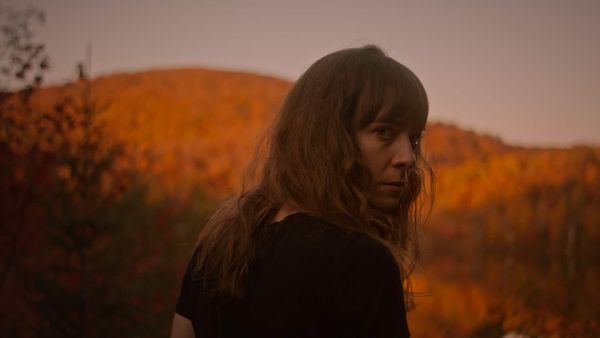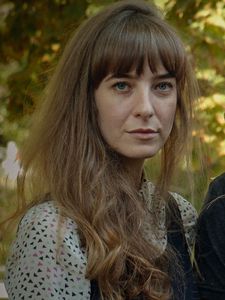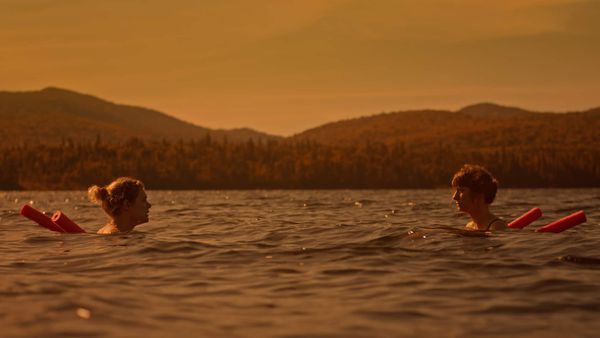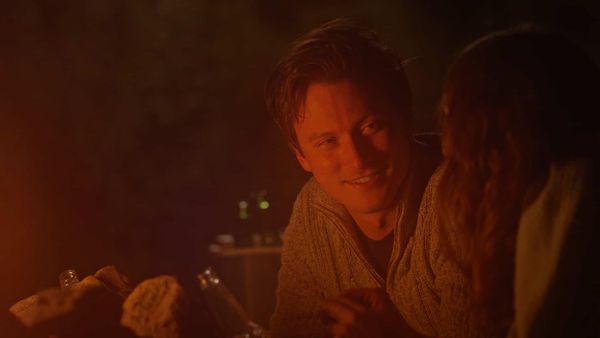 |
| Madeleine Sims-Fewer: 'We wanted to show kind of the brutal reality of what revenge in real life might look like' Photo: Shudder |
We start by talking about their working relationship, which has the added dimension of acting for Madeleine – in a part which requires every ounce of emotions.
Dustin adds: “I would say I have an incredible amount of admiration for Madeline because the amount of time that we put in just as directors and producers and to think she also had to learn her lines and watch the dailies, it was just an insane amount of work. It meant a lot of sleepless nights and working constantly so we’re really thrilled to have finally got to the other end of it.
A large chunk of the action was shot in a woodland location, including a scene between the sisters as they swim in a lake – a physical challenge for the actors in addition to executing their lines. Although Madeleine says in the end, the difficulty of the situation helped to feed the performances.
“It was a massive lake,” she explains. “So it was very, very cold body of water. And I think Anna and I spent most of our energy, trying not to shiver. So just like controlling our bodies so that we weren't convulsing the whole time.
Dustin agrees that the whole film was a challenge because it was shot with natural light. He adds: “A lot of the locations are stitched together because we're trying to get the best of both worlds. And that particular scene is shot in the mountains, in a really huge National Park in Quebec. And we were there at 5am right before the sun rose, because we knew we had a couple windows of light - we had dawn, midday and sunset.
“And we were prepared to film the scene throughout the entire day until we really nailed it. And it turned out that the best performances and the best moments were at the end of the day.”
Madeleine didn’t just commit to chilly water for a day, she was so committed to retaining the realism of the film that she made herself physically sick for one key scene.
She explains: “It was something that was really important to me as an actor to do because I feel like I've seen so many films where there is vomiting and you can just tell it's one of those one of those cinematic things where you accept it, because it's a film. But you know someone’s just put some soup in their mouth and then just spat it out or there's the vomit rig, which it's very obvious because you have to stay in a certain angle. That for me, in the script, was this pivotal moment where we see Miriam is still human. And she has this visceral bodily response to what she's done. So she's not this Dexter character, she's not clinical. And she's done this absolutely horrific thing. And she is horrified by herself. And I think that there's something that you can't fake about vomiting that your body does, it’s a convulsion. And the sounds that come from deep inside, you just can't be mimicked. So, so I did do that. And we only had one take. I think all of us felt the physical toll of the film.”
Dustin says: “I think we've over the course of our shorts were really drawn to a really naturalistic, visual aesthetic. We really want to try to create a visceral experience for the audience where we can really put them in the shoes of the main characters, they can really empathise with their internal turmoil and their struggle.
“For us, grounding the film in that in the lighting and the performance style and the violence really helps amplify your experience. I think it's an audience and there's not a lot of violence in the film, but when you do see the violence, it feels so real and because it's uninterrupted. We're so used to, in horror films, these close up shots and it's graphic but it's it almost desensitises you because of the way in which it's being portrayed, but we’d rather you feel like you're in that room and you know, the horror of what the actual act of violence looks like is more terrifying to us.
Madeleine adds: “Yeah, I think because so many revenge films kind of propel you towards the revenge and then the climax is this act of revenge and you're cheering on the protagonist to get this gruesome revenge and then there's the calm after the storm where everything's okay now, she's got her revenge. We wanted to show kind of the brutal reality of what revenge in real life might look like. And without stripping away all of that heightened quality, keeping it as grossly real as possible. So people are really confronted and affronted by this is what revenge looks like. This is the truth of it. It's not cathartic. It's not. There's no wish fulfilment. It's actually completely compounding the trauma and destroying all of the relationships around this woman.”
That lynchpin moment of violence also requires a very committed performance from Jesse LaVercombe.
“We were really lucky,” says Dustin. “We had developed a really strong collaboration with Jesse on two of our short films. And so he was in Slap Happy, and our last short, Chubby, and he played very challenging complex roles and both of those shorts. And I think when we brought him the script, we knew he'd be perfect for it. We immediately said, ‘Hey, listen, there's full frontal male nudity, this is really important to us. So if that's a problem, no worries, but don't bother reading the script, we want it to be really clear’. He didn't bat an eye. He's just such a professional. And, you know, for him, it was really about how can we make this character really complicated, so that we can really challenge audiences. What's really great about Jesse's whole approach is that he doesn't judge his character. And I think because of that, he was asking us some really tough questions about the characters motivations, that really forced us to think more deeply about the character, and hopefully flesh it out and create more of a multifaceted dimension to them.”
Madeleine says: “I think we, we always knew that the central betrayal in the film was not going to be ambiguous, that we wanted the audience to be with Miriam in that point, and to really feel the betrayal and the trauma that she goes through. But we're definitely in all of our work, very interested in not just looking at one person’s side, we want to understand the complexities of each character, and to present these characters as fully formed, real human beings.
“Even though Miriam is the protagonist, and we're with her, and she goes through an awful ordeal, she's not the greatest person. And she makes some horrific choices. And even early on, she makes some very selfish choices. But I think that's what makes human beings interesting. And that's what we want to show in our work.”
Dustin agrees. “We're so used to seeing the kind of obvious villain, the nefarious person who's you know, in the alleyway who commits these horrific acts, but in our experiences, having experienced trauma and abuse in our past, it's really often someone you trust someone you know, someone you care about someone you love. And there's something really complex about Jessie playing this affable, charming character, who we kind of like at the beginning of the film. And so when he does this thing, we feel betrayed as an audience, you know, so we have to recontextualise who this person is, as we get more information.”
Having got this first feature under their belt, the filmmakers plan to keep working together in the future. Dustin says: “We've been making shorts for five years and it was after our second short that we realised, hey, this is really working, let's join forces. So that's around the time when we decided to exclusively work together. And we're really just excited about developing a wide range of projects. We're fans of the horror genre, but it's really important to us that the next thing we do is distinctively different from Violation so that people can see our creative sensibility so we're currently writing a dark comedy and a mystery thriller but definitely we're forging forward as a as a team and we're really excited about that.”
Madeleine adds: “I think the next thing that we do I definitely don't want to act in, I think I want to take a break from that and focus on the directing side, but yeah, for sure, I will in the future when a role is right.”
Violation is available to stream on subscription service Shudder from March 25 - with a seven-day free trial available.
Watch the trailer:

























